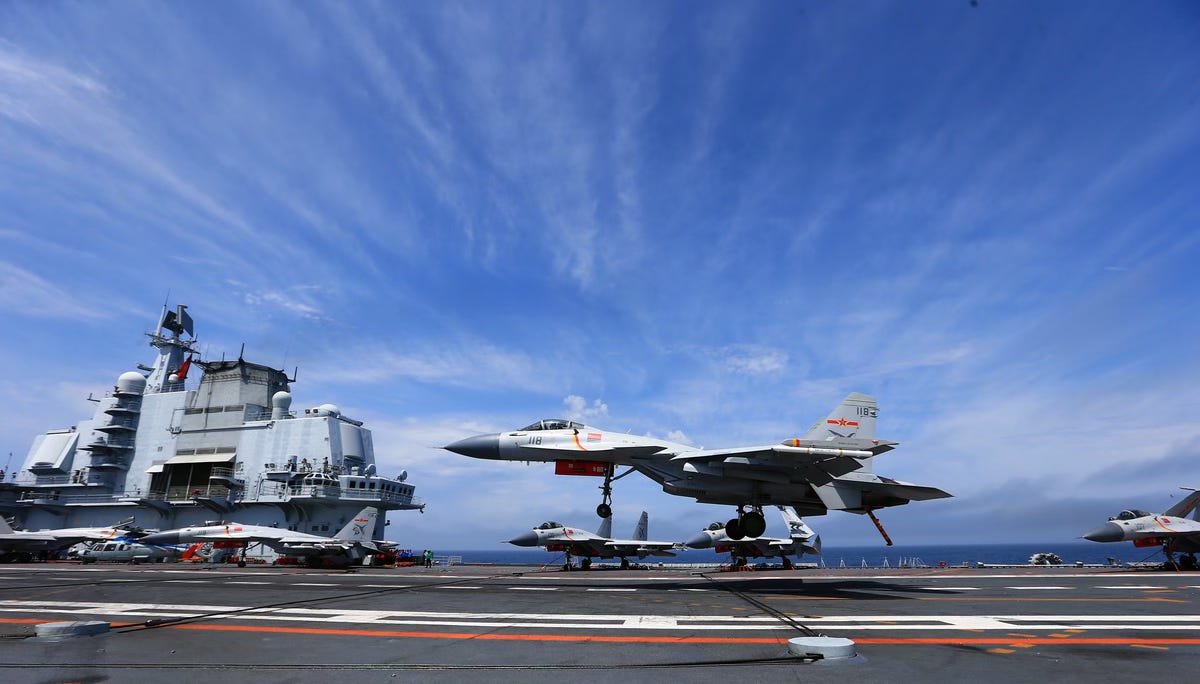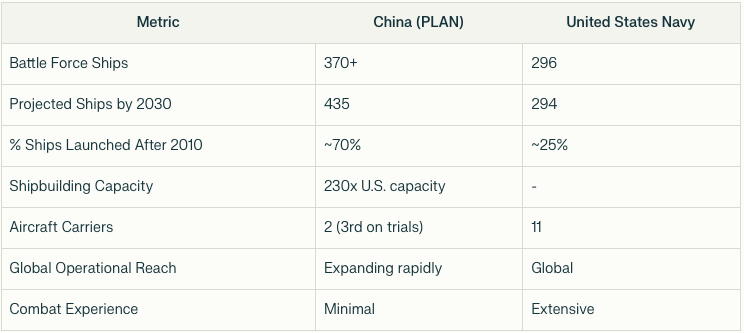Briefing: The Growth and Current Standing of China's Naval Forces
From A Regional Force To A Global Challenger

Overview
The People's Liberation Army Navy (PLAN) of China has experienced significant changes in the past thirty years to become the biggest naval fighting force globally in terms of fleet size. The expansion of naval forces has disrupted the established naval hierarchy by threatening the United States Navy supremacy in the Indo-Pacific area.
Key Developments in China's Naval Growth
World’s Largest Navy by Numbers
Between 2015 and 2020, China surpassed the United States in the number of battle force ships. As of 2024, the PLAN fields over 370 platforms, including major surface combatants, submarines, amphibious ships, mine warfare vessels, aircraft carriers, and fleet auxiliaries. Projections indicate this number will reach 395 by 2025 and 435 by 2030, while the U.S. Navy is expected to hover around 294 ships by 2030.Modernization and Quality Improvements
About 70% of Chinese warships were launched after 2010, compared to only 25% of the U.S. Navy’s fleet. While the U.S. Navy retains a qualitative edge in certain areas, the U.S. Office of Naval Intelligence assessed in 2020 that Chinese ships are increasingly of comparable quality to their American counterparts.Shipbuilding Capacity and Industrial Advantage
China’s shipbuilding industry vastly outpaces the U.S., with a capacity estimated at over 230 times greater than that of the United States. This advantage is not only in quantity but also in the ability to rapidly produce, repair, and replace warships—a strategic edge in any protracted conflict.
Comparative Table: PLAN vs. U.S. Navy (2024)
Strategic and Operational Trends
Global Reach and Activity
The PLAN now operates far beyond its traditional near-seas focus, conducting increasing deployments in the Western Pacific, Indian Ocean, and even around Europe. Live-fire exercises and Replenishment-at-Sea (RAS) operations demonstrate growing blue-water capabilities and logistical reach.Regional Assertiveness
A central objective remains asserting control over the near seas—especially the South China Sea, East China Sea, and Yellow Sea—where China uses its navy, coast guard, and maritime militia to enforce territorial claims and challenge the presence of other regional actors and the U.S..Technological and Platform Advances
The PLAN is rapidly retiring older, single-mission ships in favor of larger, multi-mission vessels equipped with advanced anti-ship, anti-air, and anti-submarine weapons and sensors.New classes, such as the Type 055 destroyers and Type 075 amphibious assault ships, are among the world’s most advanced.Firepower and Future Trajectory
China is on track to potentially surpass the U.S. Navy in certain measures of firepower by 2027, particularly in missile capacity and the number of modern surface combatants.
Limitations and Uncertainties
Combat Experience
The PLAN remains untested in modern, high-intensity naval combat. The U.S. Navy, in contrast, has extensive operational and combat experience, which remains a critical advantage.Blue Water Limitations
Despite rapid progress, the PLAN still faces challenges in long-range logistics, joint operations, anti-submarine warfare, and global basing compared to the U.S. Navy.Transparency and Data Gaps
China does not publicly release detailed force structure goals or shipbuilding plans, making long-term projections uncertain.
Strategic Implications
U.S. Response and Concerns
U.S. officials and analysts are increasingly alarmed by the pace and scale of China’s naval buildup and shipbuilding capacity. The U.S. Navy is responding by shifting more assets to the Pacific, investing in new technologies, and strengthening alliances, but faces significant industrial and budgetary constraints.Balance of Power in the Indo-Pacific
The PLAN’s growth is already altering the regional balance, enabling China to project power, threaten U.S. allies, and undermine regional stability. If current trends continue, the U.S. could face its first genuine maritime challenger since the Cold War.Long-Term Uncertainties
While China’s numerical and technological advances are narrowing the gap, the outcome of any future conflict would depend on many factors beyond fleet size, including joint force integration, strategy, leadership, and alliances.
Conclusion
China’s naval advancements have altered the international maritime equilibrium and established a major obstacle for the United States Navy. China’s technological progress together with its production capabilities has reduced the advantage the U.S. holds in quality and worldwide reach. The future paths of both navies will be determined by decisions on U.S. funding and innovation along with policy choices as well as China’s efforts to address its operational shortcomings.
Further Reading:





Excellent piece—thanks for pulling together the key developments. The PLAN’s shift toward more long-duration deployments and integrated joint operations reflects broader trends in Chinese military thinking about power projection. I cover related issues around PLA C4ISR and operational art at Orders and Observations: ordersandobservations.substack.com.
I am only unconcerned by the growth of China’s navy, I welcome it. In part, it will make the risk of military conflict less likely, as the US military currently believe (mistakenly in my view) that it can win a war with China. Otherwise, why would the US continue to be so (unnecessarily) provocative in its public actions and statements?
Please China, don’t be deterred from strengthening your military. It will help make the region (where I live) safer.